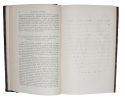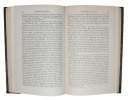-
Type
Book (448)
Magazine (4)
-
Latest
Last 24h (1)
Last 3 days (1)
Last month (2)
Last week (1)
-
Language
English (2)
French (418)
German (1)
Polish (1)
Russian (30)
-
Century
18th (2)
19th (152)
20th (128)
21st (30)
-
Countries
Belgium (20)
Canada (1)
Denmark (91)
France (277)
Germany (3)
Switzerland (28)
United States of America (32)
-
Syndicate
ALAC (1)
CLAM (2)
ILAB (228)
NVVA (5)
SLACES (5)
SLAM (117)
SNCAO (1)
L'origine des espèces au moyen de la sélection naturelle ou La lutte pour l'existence dans la nature. Collection : Marabout Université, MU 234.
Verviers, Editions Gérard/Marabout, 1973. 11 x 18, 571 pp., broché, bon état (couverture légèrement défraîchie).
L’Origine des espèces au moyen de la sélection naturelle, ou la lutte pour l’existence dans la nature. Traduit sur l’édition anglaise définitive par Ed. Barbier.
Paris, C. Reinwald 1887, 235x150mm, reliure percaline verte de l’éditeur. Coiffes légèrements frottées. Joints de liaison internes renforcés. Nom du possesseur sur le haut de la page de faux-titre. Intérieur propre, bel exemplaire.
2 ff. - XXI - 604 + 20 pages, Pour un paiement via PayPal, veuillez nous en faire la demande et nous vous enverrons une facture PayPal
L'Origine des espèces au moyen de la sélection naturelle ou la Lutte pour l'existence dans la nature
Paris, Librairie C. Reinwald - Schleicher frères, 1896. In-8, XXI-604 pp., cartonnage de l'éditeur vert, filets à froid en encadrement sur les plats, dos long orné de filets dorés (frottements, manque au premier plat, mouillure de la partie inférieure de l'ouvrage, petites rousseurs).
Édition définitive de la traduction française par Edmond Barbier, approuvée par Darwin lui-même, traduite sur la sixième édition anglaise. Le célèbre ouvrage a originalement paru en anglais en 1859 et a connu sa première traduction française en 1852 par Clémence Royer, considérée comme incomplète et orientée par Darwin. Elle avait en effet ajouté une préface, pris certaines libertés envers le texte et n'avait pas pris en compte les corrections apportées par l'auteur. Un second traducteur avait repris le flambeau et à sa mort, les éditeurs firent appel à Barbier pour en donner la présente traduction. Complet du catalogue de l'éditeur. Voir photographie(s) / See picture(s) * Membre du SLAM et de la LILA / ILAB Member. La librairie est ouverte du lundi au vendredi de 14h à 19h. Merci de nous prévenir avant de passer,certains de nos livres étant entreposés dans une réserve.
L'origine des espèces - Collection Les livres qui ont changé le monde n°1.
Flammarion / Le monde. 2009. In-8. Broché. Etat d'usage, Couv. convenable, Coiffe en pied abîmée, Papier jauni. 297 pages - coiffes abimées.. . . . Classification Dewey : 570-Sciences de la vie
Collection Les livres qui ont changé le monde n°1. Classification Dewey : 570-Sciences de la vie
"L'origine des espèces - II - ""Petite collection Maspero"" n°235"
François Maspero. 1980. In-12. Broché. Etat d'usage, Couv. légèrement pliée, Dos satisfaisant, Quelques rousseurs. Paginé de 315 à 610.. . . . Classification Dewey : 570-Sciences de la vie
Trad. de l'anglais par Edmond Barbier. Préface de Colette Guillaumin. Classification Dewey : 570-Sciences de la vie
"L'origine des espèces - ""Les livres qui ont changé le monde"" n°1"
Le Monde/Flammarion. 2009. In-8. Broché. Etat d'usage, Couv. convenable, Dos satisfaisant, Intérieur acceptable. 297 pages.. . . . Classification Dewey : 570-Sciences de la vie
Classification Dewey : 570-Sciences de la vie
L'ORIGINE DES ESPÈCES par le moyen de la sélection naturelle, ou la présevation des races favorisées dans la lutte pour la vie
Paris Honoré Champion 2009 in 12 (19x12,5) 1 fort volume broché, couverture illustrée, 918 pages [4]. Charles Robert Darwin, Shrewsbury 1809 - Downe 1882, naturaliste anglais. Edition du Bicentenaire, sous la direction de Partick Tort. Traduction par Aurélien Berra. Coordination par Michel Prum. Précédé de Patrick Tort: Naitre à vingt ans, Genèse et jeunesse de l'Origine. Bel exemplaire ( Photographies sur demande / We can send pictures of this book on simple request )
Très bon Broché
L'Origine des espèces par le moyen de la sélection naturelle ou la préservation des races favorisées dans la lutte pour la vie
Champion Champion, 2009. Fort In-8 broché de 918 pages. Très bon état
Toutes les expéditions sont faites en suivi au-dessus de 25 euros. Expédition quotidienne pour les envois simples, suivis, recommandés ou Colissimo.
Menneskets Afstamning og Parringsvalget. Oversat af J.P. Jacobsen. 2 Bd.
Kjøbenhavn, Gyldendal, 1874-75. 8vo. Bound in one contemporary half calf. Gilt spine with gilt lettering. Spine a little rubbed and upper compartment of spine with some loss of leather. (6),V,426"(2),401 pp., textillustrations. A few leaves with brownspots.
First Danish edition of ""The Descent of Man and Selection in Relation to Sex"". Freeman: No 1050.
Menneskets Afstamning og Parringsvalget. Oversat af J.P. Jacobsen. 2 Bd.
Kjøbenhavn, Gyldendal, 1874-75. 8vo. Bound in one contemporary half calf. Gilt spine, titlelabel with gilt lettering. Light edgewear and light wear to spineends. (6),V,426"(2),401 pp., textillustrations. Internally clean and fine.
First Danish edition of ""The Descent of Man and Selection in Relation to Sex"". Freeman: No 1050.
Menneskets Afstamning og Parringsvalget. Oversat af J.P. Jacobsen. 2 vols. - [FIRST DANISH EDITION OF ""THE DESCENT OM MAN""]
Kjøbenhavn, Gyldendal, 1874-1875. 8vo. Two parts bound in one nice contemporary half calf binding (Anker Kyster) with gilt lettering and ornamentation to spine. A few scratches to spine. Ex-libris pasted on to pasted down front end paper. A nice and clean copy. (6), V, 426 pp. (2), 401 pp.
First Danish edition of ""The Descent of Man and Selection in Relation to Sex"". Freeman: No 1050.
Menneskets Afstamning og Parringsvalget. Oversat af J.P. Jacobsen. 2 vols. - [FIRST DANISH EDITION OF ""THE DESCENT OM MAN""]
Kjøbenhavn, Gyldendal, 1874-1875. 8vo. Two parts bound in one contemporary half calf binding with gilt lettering and ornamentation to spine. Some wear to binding. Previous owner's name in contemporary hand to title-page. Internally with occassional brownpostting. (6), V, 426 pp. (2), 401 pp.
First Danish edition of ""The Descent of Man and Selection in Relation to Sex"".Freeman: No 1050.
Menniskans Härledning och Könsurvalet. [English: ""The Descent of Man""). 2 vols. - [FIRST SWEDISH TRANSLATION OF ""THE DESCENT OF MAN""]
Stockholm, Albert Bonniers, 1872. 8vo. 2 volumes in one (as issued) contemporary half calf binding with gilt lettering to spine. A fine and clean copy. (Frontiespiece), (1), 314, (2) pp."" (4), XV, (1), 294, (6), 39 pp.
The rare first Swedish translation of ""The Descent of Man"" translated by Rudolf Sunderström. Freeman's collation is incorrect (as he also dated the first Swedish translation of ""Origin of Species"" wrongly).Withbound is Lawrence Heap Åberg's ""Ett försök att uppvisa darwinismens öfverensstämmelse med en rationelt idealistisk verldsåskådning"" (1874). Freeman 1136
Nasekomoyadnye rasteniya [i.e. Russian: ""Insectivorous Plants""], [3 issues, all]. - [FIRST RUSSIAN TRANSLATION OF 'INSECTIVOROUS PLANTS' ]
Moscow, izdanie V. P. Plemânnikova, 1876. 8vo. 3 parts bound in 2 uniform contemporary full cloth bindings with blind stamped titles to spines. Some soiling to extremities and part of cloth around hinges worn of. Internally with occassional brownspotting. (4), 168, (2), 393, (1), VII, (2) pp. + 4 folded plates.
Rare first Russian translation of Darwin’s Insectivorous Plants published only one year after the English original. Freeman F1244OCLC only locates one copy (in Poland), Huntinton in Pasadena also holds a copy.
Naturwissenschaftliche Reisen nach den Inseln des grünen Vorgebirges, Südamerika, der Feuerlande, den Falkland-Inseln, Chiloe-Inseln, Galapagos-Inseln, Otaheiti, Neuholland, Neuseeland, Van Diemen's Land, Keeling-Inseln, Mauritius, St. Helena, den Azoren ec. Deutsch und mit Anmerkungen von Ernst Dieffenbach.
Zwei Teile in einem Band. Braunschweig, Friedrich Vieweg und Sohn, 1844. 8°. XVI, 319 S.; VIII, 301 S. Mit 1 gef. Karte. Moderner Leinenband.
Freeman 188. – Erste deutsche Ausgabe. – Das Papier durchgehend stärker stockfleckig und gebräunt.
Naturwissenschaftliche Reisen nach den Inseln des grünen Vorgebirges, Sudamerika, dem Feuerlande, den Faltland-Inseln, Chiloe-Inseln, Galapagos-Inseln, Otaheiti, Neuholland, Neuseeland, Ban Diemen's Land, Keeling-Inseln, Mauritius, St. Helena, den Vz... - [FIRST TRANSLATION OF ANY OF DARWIN'S WORK]
Brunswick, F. Vieweg und Sohn, 1844. 8vo. 2 volumes bound in one contemporary half calf binding with gilt lettering to spine. Previous owner's stamp to front free end-paper. Light brownspotting throughout, especially to first and last leaves. XVI, 319, VIII, 301, (3) pp. + 1 folded map.
Rare first German translation of Darwin's Journal of researches, now known as Voyage of the Beagle, constituting the very first translation of any of Darwin's works into any language. As Darwin later recalled in his autobiography 'The voyage of the Beagle has been by far the most important event in my life and has determined my whole career'. ""On its first appearance in its own right, also in 1839, it was called Journal of researches into the geology and natural history etc. The second edition, of 1845, transposes 'geology' and 'natural history' to read Journal of researches into the natural history and geology etc., and the spine title is Naturalist's voyage. The final definitive text of 1860 has the same wording on the title page, but the spine readsNaturalist's voyage round the world, and the fourteenth thousand of 1879 places A naturalist's voyage on the title page. The voyage of the Beagle first appears as a title in the Harmsworth Library edition of 1905. It is a bad title: she was only a floating home for Darwin, on which, in spite of good companionship, he was cramped and miserably sea-sick"" whilst the book is almost entirely about his expeditions on land."" (Freeman)Freeman 176
Notes on the Effects produced by the Ancient Glaciers of Caernarvonshire, and on the Boulders transported by Floating Ice.
London, University of London, 1842. 8vo. In contemporary half calf. In ""The London, Edinburgh, and Dublin Philosophical Magazine and Journal of Science"", Vol. XXI. July - December, entire volume offered. Spine with wear and lacking bits of the leather especially affecting front hinge. Leather brittle. Front hindge loose. Exlibris pasted on to pasted down front end-paper. Internally nice and clean. [Darwin's paper:] Pp. 180-88. [Entire volume: viii, 568 pp.].
First appearance of Darwin’s paper on the effects produced by the glaciers of Caernarvonshire. In 1831 Charles Darwin came to Cwm Idwal and failed to perceive the evidence of glaciation there. In 1842, Darwin then went on to describe the glaciation of Cwm Idwal in some detail. He recorded both his first visit with the Cambridge geologist Adam Sedgwick and his second, more aware, visit in his autobiography: “Next morning we started for Llangollen, Conway, Bangor, and Capel Curig. This tour was of decided use in teaching me a little how to make out the geology of a country. Sedgwick often sent me on a line parallel to his, telling me to bring back specimens of the rocks and to mark the stratification on a map. On this tour I had a striking instance of how easy it is to overlook phenomena, however conspicuous, before they have been observed by any one. We spent many hours in Cwm Idwal, examining all the rocks with extreme care, as Sedgwick was anxious to find fossils in them" but neither of us saw a trace of the wonderful glacial phenomena all around us we did not notice the plainly scored rocks, the perched boulders, the lateral and terminal moraines. Yet these phenomena are so conspicuous that, as I declared in a paper published many years afterwards in the ‘Philosophical Magazine’ [Darwin, 1842], a house burnt down by fire did not tell its story more plainly than did this valley. If it had still been filled by a glacier, the phenomena would have been less distinct than they now are. (Darwin, 1887)” “By 1842, not only had Darwin travelled widely (Herbert, 1991) but Agassiz (1840) had published his theory of glaciation. Darwin was also then apprised of the arguments of the geologist William Buckland. Buckland was known for his penchant for eating every variety of animal, a trait which his son inherited (Burgess, 1967: Chapter 1 Chorley et al., 1964: 100–118 see also Lewry, 2008) but he also developed highly significant ideas on glaciation and the limitations of the diluvial theory (Chorley et al., 1964: 207–210). A key realization is that water-lain flood deposits are normally laid down in stratified layers, with the coarser material below the fine, while the glacial deposits are unstratified and mixed in size. Thus, in contrast to his earlier 1831 lack of glacial observation” (Trudgill, Do theories tell us what to see? The 19th-century observations of Darwin, Ramsay and Bonney on glacial features), Darwin wrote: “Guided and taught by the abstract of Dr. Buckland’s memoir ‘On Diluvio-Glacial Phænomena in Snowdonia and the adjacent parts of North Wales’ I visited several of the localities there noticed, and ... I have been enabled to make a few additional observations. Dr. Buckland has stated that a mile east of Lake Ogwyn there occurs a series of mounds, covered with hundreds of large blocks of stone, which approach nearer to the condition of an undisturbed moraine, than any other mounds of detritus noticed by him in North Wales. By ascending these mounds it is indeed easy to imagine that they formed the north-western lateral moraine of a Trudgill 559 Downloaded from ppg.sagepub.com at PENNSYLVANIA STATE UNIV on September 16, 2016 glacier, descending in a north-east line from the Great Glyder mountain. But at the southern end of Lake Idwell the phænomena of moraines are presented, though on a much smaller scale, with perfect distinctness. (From the present paper, p. 180)” Darwin then gives a detailed description of the glacial features: “On entering the wild amphitheatre in which Lake Idwell lies, some small conical, irregular little mounds, which might easily escape attention, may be seen at the further end. The best preserved mounds lie on the west side of the great black perpendicular face of rock, forming the southern boundary of the lake. They have been intersected in many places by streams, and they are seen to consist of earth and detritus, with great blocks of rock on their summits. They at first appear quite irregularly grouped, but to a person ascending any one of those furthest from the precipice, they are at once seen to fall into three (with traces of a fourth) narrow straight linear ridges. The ridge nearest the precipice runs someway up the mountain, but the outer one is longer and more perfect, and forms a trough with the mountain-side, from 10 to 15 feet deep. On the eastern and opposite side of the head of the lake, corresponding but less developed mounds of detritus may be seen running a little way up the mountain. It is, I think, impossible for any one who has read the descriptions of the moraines bordering the existing glaciers in the Alps, to stand on these mounds and for an instant to doubt that they are ancient moraines nor is it possible to conceive any other cause which could have abruptly thrown up these long narrow steep mounds of unstratified detritus against the mountain-sides. (From the present paper, p. 180)”
Obrazovanie rastitel'nago sloa deatel'nost'u dozdevyh cervej i nabludenia nad obrazom zizni poslednih. [i.e. ""Vegetable Mould and Worms""]. [Translated by:] Mihail Aleksandrovic Menzbir.
Moscow, S. P. Arkhipov. 1882. 8vo. In contemporary half calf. Wear to extremities and small stamp to upper right corner of title-page, internally fine and clean. IV, 186 pp.
Second Russian translation, published the same year as the first Russian and the year after the original English, of Dawin's ""Vegetable Mould and Worms"". ""This last book is outside the main stream of Darwin's work, and reverts to his earlier geological interests. He had indeed published papers on mould in 1838 and in 1840. The book was remarkably successful, selling 6000 copies within a year, and 13000 before the end of the century"". (Freeman). Freeman 1409
Observations on the Parallel Roads of Glen Roy, and of other parts of Lochaber in Scotland, with an attempt to prove that they are of marine origin.
(London, Richard and John E. Taylor, 1839). 4to. Without wrappers. Extracted from ""Philosophical Transactions of the Royal Society of London."", 1839, Part I. Pp. 39-81 and 2 plates. (1 engraved map and 1 lithographed plate). Both plates with a few brownspots.
First appearance of Darwin's investigations of the geological phenomenon of the so-called ""Parallel Roads"" in Scotland.""The first published description of the Parallel Roads was by Thomas Pennant in 1771 in his book A Tour of Scotland. This work was far from scientific but during the 19th century Glen Roy played an important role in the development of geological and geomophological theories of landscape evolution.1 Initially the 'Roads' were believed to be lake or marine shorelines. How they were formed in an area that was now high above the sea and without signs of a closed lake bed was a mystery. Initially it was thought that the shorelines were of marine origin and formed during a period when the sea reached levels of the Parallel Roads. Among the proponent of this theory were both Charles Darwin and Charles Lyell.2 It was in particular Darwin who was impressed by the geology of Glen Roy. In 1838 he wrote to Lyell, ""I wandered the mountains in All directions and examined that most extraordinary district. I think without any exceptions, not even the first volcanic island, the first elevated beach, or the passage of the Cordillera, as so interesting to me as this week. It is far the most remarkable area I ever examined. ... I can assure you Glen Roy has astonished me"".3 Darwin and Lyell proved to be wrong in this matter."" (Jan Oosthoek). Freeman 1653.
Observations on the Structure and Propagation of the genus Sagitta. - [""ONE OF THE MOST ANOMALOUS ANIMALS IN THE WORLD""]
London, Taylor and Francis, 1844. 8vo. In a nice later half morocco binding with five raised bands and gilt lettering to spine. Blind stamped to upper outer corner of first leaf of table of contents. In ""The Annals and Magazine of Natural History"", volume 13. A very fine and clean copy. [Darwin's paper] pp. (1)-6 + 1 plate. [Entire volume:] viii, [1] - 528 + 14 plates (4 hand-coloured).
First edition of Darwin's paper on marine arrow worms collected by him on his voyage on the Beagle. It is one of Darwin's early papers on invertebrates, which was originally intended for publication in The Zoology of the Voyage of HMS Beagle. Described by Darwin as ""one of the most anomalous animals in the world,"" the origin of these strange carnivorous animals, which Darwin found highly interesting, is still unresolved. These early works are rarely seen on the market. The plate, drawn by Darwin, is based on his drawings made during the Beagle Voyage.Darwin arrived back in England from his voyage around the world on the Beagle in October 1836. He immediately set about writing up the results of the expedition-first, his general account, the Journal of the Beagle, and then, publishing the scientific observations and collections he had made while on the Beagle. The majority of these were published in the Zoology-including parts on mammals, fish, birds, and reptiles but Darwin ran out of funds beforehe could bring out the volume on invertebrates:""Darwin undertook to provide a comprehensive programme for the publication of the zoological results of the Beagle voyage - he obtained a Treasury grant to pay for the necessary engravings, and, having enlisted the leading taxonomical specialists in the several fields, he superintended the publication of the Zoology of the voyage of H.M.S. Beagle from February 1838 to October 1843 - The work comprises five parts: Fossil Mammalia, by Richard Owen" Mammalia, by G. R. Waterhouse Birds, by John Gould Fish, by Leonard Jenyns" and Reptiles, by Thomas Bell-a total of nineteen quarto issues. Darwin contributed a substantial portion of the text, drawing uponhis field notes for geological and geographical data and for the descriptions of the habits and habitats of the species - Darwin had originally planned to include descriptions of invertebrates in the Zoology but the exhaustion ofthe government grant forced him to abandon the idea. Instead he decided to publish his own observations and descriptions of the specimens that he considered to be important new discoveries, and did so in articles on Sagitta finished during the autumn of 1843, and Planariae, described in 1844"" (Burkhardt 1986 p. xv.).PROVENANCE: From the collection William Pickett Harris, Jr. (1897 - 1972) (pencil note on p. iii). American investment banker and biologist. Following a career in banking, Harris was appointed Associate Curator of the Museum of Zoology at the University of Michigan in 1928. ""[Harris] played a highly important role in developing mammalogy and systematic collections of mammals at the University of Michigan"" (Hooper p. 923).Freeman 1664.
Om Arternas Uppkomst genom naturligt Urval eller de bäst utrustade rasernas Bestånd i Kampen för Tillvaron. Öfversättning från femte Originalupplagan af A.M. Selling. - [FIRST SWEDISH TRANSLATION OF DARWIN'S ORIGIN OF SPECIES]
Stockholm, L.J. Hiertas Förlagsexpedition, 1871. 8vo. Contemporary half calf with gilt lettering to spine and gilt ornamentation forming five compartments. Hindges with a few worm holes, back hindges mostly affected, but binding still tight and firmly attached to book block. Previous owner's stamp to pasted down front end-paper. Internally extraordinarily fine and clean. XI, (1), 420 pp. + plate with genealogical tree inserted between p. 96 and p. 97.
The rare first Swedish translation, also being the first in Scandinavia, of Darwin's Origin of Species. Initially the work mainly received attention from religious institutions who (also compared to most other countries) were fiercely against Darwin's theory. Freeman wrongly lists this first Swedish edition as appearing in 1869, he also does not register the plate.
Om Arternes Oprindelse ved Kvalitetsvalg (Danish) + Arternes Oprindelse gjennem naturligt Udvalg (Norwegian) + Om Arternas Uppkomst genom naturligt Urval (Swedish). - [INTRODUCTION OF THE ""ORIGIN"" IN SCANDINAVIA]
Kjøbenhavn [Copenhagen], 1872 - (Kristiania [Oslo], 1890) - Stockholm, 1871. A very nice and harmonious set, in four excellent half calf bindings.1) The Danish translation: 1 volume 8vo. A nice contemporary half calf with gilding to spine and gilt title-label. Only light wear. Internally some light brownspotting. (19), XIII, 605, (1) pp.2) The Norwegian translation: 2 volumes small 8vo. Bound in two excellent, uniform, recent red morocco bindings in pastiche-style, with gilt lines to spines. The work is printed in quite bad paper, which is always yellowed and quite brittle. Thus, the first title-page has two small restorations from verso, far from arrecting printing. The second title-page had an old owener's signature and a previous owner's stamp. 379, (5)"" 383 pp.3) The Swedish translation: 1 volume large 8vo. Bound uncut and with the extremely scarce original front wrapper in a lovely later brown half morrocco binding in contemporary style, with five raised bands and gilt author and year to spine. Front wrapper bound on a strip at inner hinge and with a missing outer coner (far from affecting printing). Old owner's name to front wrapper. An excellent copy. XI, (1), 420 pp.
A magnificent collection of first editions of the first Danish, Norwegian and Swedish translations of Darwin's masterpiece ""The Origin of Species"", together constituting the introduction to ""The Darwinian Revolution in Scandinavia"".The first Scandinavian translation to appear was the Swedish, which is also the rarest of the three. Darwinism was strongly opposed in Sweden, where the primary reaction to the work came from religious institutions that were outraged and fiercely fought against spreading the ideas presented in ""origin"" in their country. The second Scandinavian translation to appear was the Danish, which was translated in 1872 by the then young botanist J. P. Jacobsen, who was soon to become one f Scandinavia's most celebrated and influential authors. He received world-wide fame as the author of ""Marie Grubbe"" and ""Niels Lyhne"", which founded literary naturalism in Europe. ""In the early 1870's, however, he was still dedicated to science. In 1873 he received the University of Copenhagen's Gold Medal for his work on desmids, single-celled green freshwater algae. The Descent of Man was also translated by Jacobsen and appeared in 1874-75.""Darwin's ideas found great resonance in scientific circles in Denmark, and his ideas were immediately recognized. ""In the early 1870s [With the Danish translation] the literary critic Georg Brandes started promoting Darwin's ideas as part of his liberal ideology and soon Darwinism became the mark of a new generation of intellectuals. Both the Steenstrup circle and the Brandes circle held Darwin in high esteem, but made completely different attributions to his theory. Consequently they both decided to raise money separately for the same Darwin. Darwin had borrowed the collection of barnacles from the Zoology Museum in Copenhagen with the help of Steenstrup. As a compliment Darwin sent him a signed copy of the Origin. Steenstrup acknowledged Darwin as an important fellow naturalist, but like many of his colleagues at the University of Copenhagen he never accepted evolutionary theory. The initial scientific reaction to Darwin's work on evolution by means of natural selection was respectful, but made few converts. memorial in 1882. Independently, Darwinism transformed as it became part of popular culture. "" (Kjærsgaard, Darwinism comes to Denmark).The Norwegian translation was the last of the three to appear, but it is quite scarce and very difficult to come by. It was published by businessman and publisher Johan Sørensen (1830-1918) as a part of 'Bibliothek for de tusen hjem' (Library for Every Home).""The first volume came out at the end of 1889, in five parts and a total of 379 pages. Each part cost 30 øre, making a total price of 1 kroner 50 øre. The following year, 1890, the second volume appeared and this consisted of four parts totaling 383 pages and cost 1 kroner 20 øre. The books were translated from the English sixth and final edition by the Master of the Arendal Public Secondary College, Ingebret Suleng (1852-1928)"" (Glick, The Reception of Charles Darwin in Europe).1. The Danish translation: Om Arternes Oprindelse ved Kvalitetsvalg eller ved de heldigst stillede Formers Sejr i Kampen for Tilværelsen. Efter Originalens femte Udgave oversat af J.P. Jacobsen. Kjøbenhavn, Gyldendalske Boghandel (F. Hegel), 1872. 8vo. (10),XIII,605,(1) pp. - Freeman No 643 (Freeman with wrong collation, as he omits half-title and content-leaves).2. The Norwegian translation: Arternes Oprindelse gjennem naturligt Udvalg eller de bedst skikkede Formers bevarelse i Striden for Livet. Oversat efter Originalens VI. Udgave af Ingebret Suleng. (I-) II. (Kristiania), Bibliothek for de tusen hjem. Fagerstrand pr. Høvik, (1890). Small 8vo. (1-3)4-379,(4)"(1-3)4-383 pp. - Not in Freeman.3. The Swedish translation: Om Arternas Uppkomst genom naturligt Urval eller de bäst utrustade Rasernas Bestånd i Kampen för Tillvaron. Öfversättning från femte Originalupplagan af A.M. Selling. Stockholm, L.J. Hiertas Förlagsexpedition, 1871. (I-IV)V-XI,420 pp., 1 plate. - Freeman No 793 (Freeman having the wrong year of publication and not mentioning the plate).
Om Arternes Oprindelse ved Kvalitetsvalg eller ved de heldigst stillede Formers Sejr i Kampen for Tilværelsen. Efter Originalens femte Udgave oversat af J.P. Jacobsen. - [FIRST DANISH EDITION OF ""THE ORIGIN OF SPECIES"".]
Kjøbenhavn, Gyldendalske Boghandel (F. Hegel), 1872. 8vo. Bound in contemporary half calf with 4 raised bands and gilt lettering to spine. Spine rubbed. A few light brownspots throughout. Otherwise a fine and clean copy. (10), XIII, 605, (1) + 1 plate.
The Scarce first Danish edition (translated from the 5. edition) of Darwin's monumental ""On the Origin of Species"". ""In 1872 the book was translated into Danish by the young botanist J. P. Jacobsen. He was soon to become a celebrated novelist famous for Marie Grubbe - A Lady of the Seventeenth Century (1876) and Niels Lyhne (1880). In the early 1870's, however, he was still dedicated to science. In 1873 he received the University of Copenhagen's Gold Medal for his work on desmids, single-celled green freshwater algae. The Descent of Man was also translated by Jacobsen and appeared in 1874-75. ""In the early 1870s [With the Danish translation] the literary critic Georg Brandes started promoting Darwin's ideas as part of his liberal ideology and soon Darwinism became the mark of a new generation of intellectuals. Both the Steenstrup circle and the Brandes circle held Darwin in high esteem, but made completely different attributions to his theory. Consequently they both decided to raise money separately for the same Darwin. Darwin had borrowed the collection of barnacles from the Zoology Museum in Copenhagen with the help of Steenstrup. As a compliment Darwin sent him a signed copy of the Origin. Steenstrup acknowledged Darwin as an important fellow naturalist, but like many of his colleagues at the University of Copenhagen he never accepted evolutionary theory. The initial scientific reaction to Darwin's work on evolution by means of natural selection was respectful, but made few converts. memorial in 1882. Independently, Darwinism transformed as it became part of popular culture. ""(Kjærsgaard, Darwinism comes to Denmark)Freeman: 643. (PMM 344 - first edition)
On the origin of species (a fascsimile of the 1st edition with an introduction)
Harvard University Press. 2003. In-8. Broché. Bon état, Coins frottés, Dos satisfaisant, Papier jauni. 513 pages. Rares rousseurs. Texte en anglais.. . . . Classification Dewey : 420-Langue anglaise. Anglo-saxon
Introduction par Ernst Mayr. Classification Dewey : 420-Langue anglaise. Anglo-saxon
On the origin of species. - [FIRST AUSTRALIAN 'ORIGIN OF SPECIES'.]
Adelaide, The Limited Editions Club, 1963. 4to. In half wallaby over paper covered boards, imitating wooden boards. Spine in black wallaby hide with gilt lettering and ornamentation with green inlaid label. XXXII, 470 pp. + 6 engraved coloured plates and 72 illustrations in text. The paper was also produced in Australia for this specific edition. No. 785 out of 1500 copies. Housed in a green slip-case. A fine and clean copy.
First Australian edition of Darwin’s seminal ‘Origin of Spcies’, here – to honor this copy’s Australian origin – bound in wallaby hide and printed on paper produced in Australia. The Limited Editions Club was founded by George Macy in 1929 to publish finely printed, illustrated, and bound editions of literary classics in editions limited to 1500 copies. The books were available on a subscription basis. The company continued to produce books through multiple changes in ownership, but has not released new books since 2010.
 Write to the booksellers
Write to the booksellers
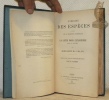









![Menneskets Afstamning og Parringsvalget. Oversat af J.P. Jacobsen. 2 vols. - [FIRST DANISH EDITION OF ""THE DESCENT OM MAN""]. "DARWIN, CHARLES.](https://static.livre-rare-book.com/pictures/LLX/62766_1_thumb.jpg)
![Menneskets Afstamning og Parringsvalget. Oversat af J.P. Jacobsen. 2 vols. - [FIRST DANISH EDITION OF ""THE DESCENT OM MAN""]. "DARWIN, CHARLES.](https://static.livre-rare-book.com/pictures/LLX/62766_2_thumb.jpg)
![Menneskets Afstamning og Parringsvalget. Oversat af J.P. Jacobsen. 2 vols. - [FIRST DANISH EDITION OF ""THE DESCENT OM MAN""]. "DARWIN, CHARLES.](https://static.livre-rare-book.com/pictures/LLX/62766_3_thumb.jpg)



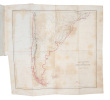
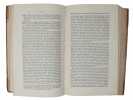



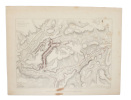
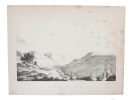
![Observations on the Structure and Propagation of the genus Sagitta. - [""ONE OF THE MOST ANOMALOUS ANIMALS IN THE WORLD""]. "DARWIN, CHARLES.](https://static.livre-rare-book.com/pictures/LLX/56990_1_thumb.jpg)
![Observations on the Structure and Propagation of the genus Sagitta. - [""ONE OF THE MOST ANOMALOUS ANIMALS IN THE WORLD""]. "DARWIN, CHARLES.](https://static.livre-rare-book.com/pictures/LLX/56990_2_thumb.jpg)
![Observations on the Structure and Propagation of the genus Sagitta. - [""ONE OF THE MOST ANOMALOUS ANIMALS IN THE WORLD""]. "DARWIN, CHARLES.](https://static.livre-rare-book.com/pictures/LLX/56990_3_thumb.jpg)

